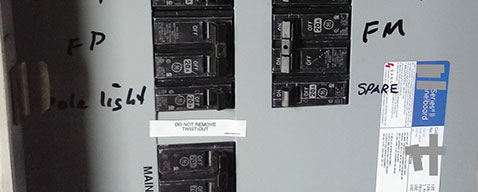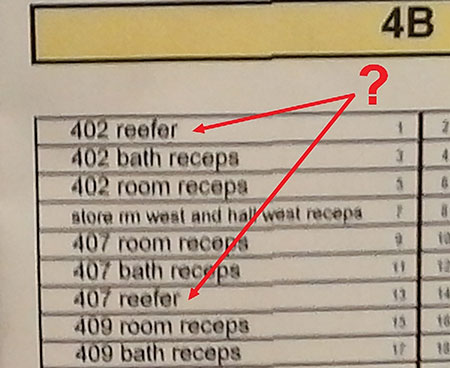I AM FORTUNATE that I work for an AHJ that allows me to express myself so freely. I can write just about whatever I want, whenever I want. Wyoming has always been known for upholding individual freedoms. For that, I owe the Great State of Wyoming a great debt of gratitude. The National Electrical Code, however, offers us no such convenience. It informs us when we need to write something. At times, it goes even further and tells us exactly how to write it. In this article, I will talk about labeling requirements, as mandated in the 2014 NEC.
Proper labeling is one of the most important code requirements
It never ceases to amaze me how many times I roll up on a jobsite, where the contractor has requested an inspection, only to find that the required labeling or circuit identification has not yet been accomplished. This delay seems to be especially true for solar installations in certain parts of the country. I’ve said before and I’ll say it again: proper labeling is one of the most important code requirements. It can make the difference as to whether something can be shut down in a reasonable amount of time or whether a tragedy might occur.
If we look at Article 408.4, it is apparent that the labeling requirements (in general) have become even more stringent as code cycles evolve. The 2014 electrical code states that the circuit identification must have an approved degree of detail that allows each circuit to be distinguished from all others. This requirement is an important clarification and is new to the 2014 Code. Exactly what constitutes an “approved degree of detail?” I’m not exactly sure. It may differ from inspector to inspector. But I can give you a few examples that I’ve encountered over the years of what an approved degree of detail definitely IS NOT.
“GoD” — the circuit breaker to God?
I saw this on a residential panel. It was written in the panel schedule for one of the circuit breakers. Now, what could it possibly mean? As I stood there dumbfounded, scratching my head, I had to think back for a minute to the days that I was an electrician. Had I ever wired a circuit . . . to heaven? Just think, if I turned off that circuit breaker, I would deny God the electrical energy that He so rightfully deserves! Of course, I’m being sarcastic to prove a point.
After I turned down the job—citing a violation of both 110.22(A) and 408.4—I received a phone call. I was told that it was my fault. I was being ridiculous! I was informed that I was the only electrical inspector in the entire universe that would ever think to write a correction notice for something as insignificant as labeling. The identification obviously meant “garage door opener.” The electrician abbreviated, using a capital “G” and then a lower-case “a” (it looked like an “o” to me) and then finally a capital “D.” See how silly I was? How could I possibly not approve this?
“Gen’l light” — It means that it’s a light . . . somewhere, but where?
As inspectors, we’ve probably all seen this. In fact, there may be AHJs out there who still allow this. This is supposed to mean “general lighting.” Unless I were in a very small building consisting of only one room, I would consider this to be a code violation. As discussed earlier, Article 408.4 requires an approved degree of detail. Another way to say this is that the code does not allow panel schedules to describe in mere generalities. Therefore, the term “general lighting” is exactly what the code is trying to prohibit. Given that fact, there is no way that an abbreviated version of that same term would be acceptable. Another version of this that I’ve encountered is “Gen’l recpt.” Try to guess what the next one means.
“d+d”— Are we learning algebra here?
I work for many jurisdictions throughout the nation, sometimes filling in for inspectors when the regular inspectors take time off to go on vacation. In one particular jurisdiction, I was amazed that all the panels in this residential subdivision had this perplexing algebraic expression for one of the circuit breakers. I wrote a violation because I was not able to immediately identify what “d+d” actually meant.
As luck would have it, it was the same electrical contractor who had labelled “the circuit breaker to God” earlier. Now, he wasn’t just mad; he was really, really mad. Again, I was the only electrical inspector in the Milky Way galaxy who would red-tag something like this, or so he thought. After he had calmed down a bit, he explained to me that d+d obviously meant “dishwasher and disposal.” This particular jurisdiction allowed for the dishwasher and the garbage disposal to be on the same circuit since the ampacity fell within the limit. So that is how the installer identified this particular circuit.
I tried to explain to him that proper circuit identification had to be such that the ordinary layperson (I commonly use Grandma as an example) is able to figure out what the circuit breaker controls. Think of Grandma trying to figure out what d+d means, in the event of an emergency. Would she be able to? In this case, I wasn’t able to and I was the electrical inspector. So I didn’t feel too bad for writing it up. An approved degree of detail was needed.
In some cases when there is not enough space to write, it may be necessary to use some abbreviation or to reprint the panel schedule in its entirety. Inspectors, please don’t allow lousy abbreviations to be used to identify circuits. I’ll give you another example below.
“FACP” — ?
This is another typical abbreviation, commonly seen on commercial projects, that boggles my mind. Nowhere in the electrical code does it allow for this abbreviation, but this is what I see on panel schedules (more often than not). I also encounter this abbreviation on many plans prepared by architects and engineers. They write it into the panel schedule. Article 760.41 clearly states that the fire alarm circuit should be identified as FIRE ALARM CIRCUIT. In fact, if one delves into NFPA 72, National Fire Alarm and Signaling Code, one will see that the circuit breaker identification must specifically say, “FIRE ALARM.”
Inspectors ought not to let contractors label the fire alarm circuit as FACP. Grandma does not know what FACP means. She would not even fathom that it equates to “Fire Alarm Control Panel.” The purpose of labeling isn’t just for the installer and the contractor. The labeling should be able to be understood by the ordinary layperson. So, all you architects and engineers out there that prepare plans including but not limited to panel schedules, please start using the term FIRE ALARM CIRCUIT, or FIRE ALARM, and not FACP. Be kind to Grandma, huh?
“FD” and “FM” ? — or is it “FP”?
Look for a moment at this example. I don’t know what the abbreviations mean. Would you approve this? Does this constitute an approved degree of detail?

“reefer” — Am I standing in a marijuana factory?
As an inspector, I pretty much thought I’d seen everything. Then one day I ran across this. What the heck is “reefer” supposed to mean? This was actually the circuit identification that I encountered for a hotel project. There were several subpanels scattered about the hotel. In each subpanel, there were circuits labelled as “reefer.” It turned out that the electrician’s helper wanted to be original, so this is how he labelled the circuits for the refrigerators. I immediately jotted this down as a violation. The circuits for a refrigerator can be correctly labelled as “refrigerator.” C’mon people . . !
I challenge you as an inspector to take a fresh look at what you have been approving as “acceptable” labeling and see if you can make it better.”

All electrical professionals would do well to remember that labeling isn’t just for their own use. It is for the use of the layperson. The layperson may not understand terms or abbreviations that an electrical journeyman or master may use. Article 408.4 now requires an approved degree of detail, and the intent here is to make it completely obvious to everyone as to what the circuit breaker controls. If a circuit is labelled properly, there should be no room left for misinterpretation.
My advice to installers is simple but important: Take the time to label the panel correctly. Don’t think of this part of the job as something to do quickly at the end of the installation and without putting much thought behind it. You may just avoid a tragedy if someone can shut something down quickly.
My advice to inspectors is also simple but important: Don’t settle for just anything being written on the panel schedule. It is somewhat normal for an inspector (including myself) not to question something when it has been the accepted practice for a long period. I challenge you as an inspector to take a fresh look at what you have been approving as “acceptable” labeling and see if you can make it better. Ninety-nine percent of the time the contractor is more than willing to comply if you just give them warning of what you would like to see written.
Going forward…
When the 2020 Code opens for public input, I may submit a code change on Article 408.4, stating that the identification should be distinguishable by the layperson. My public input would probably read something like this: “The identification shall include an approved degree of detail that allows each circuit to be distinguished from all others by the layperson.” Or perhaps this: “The identification shall include an approved degree of detail that allows each circuit to be easily distinguished from all others by other than the qualified person.” Although I believe that the code is clear and already means that, we obviously have lots of people in the trade that don’t realize this. Do you have any examples of inadequate labeling? Post them in the feedback section online in our IAEI LinkedIn group.
In closing, I wish you all happy and safe wiring!














Find Us on Socials